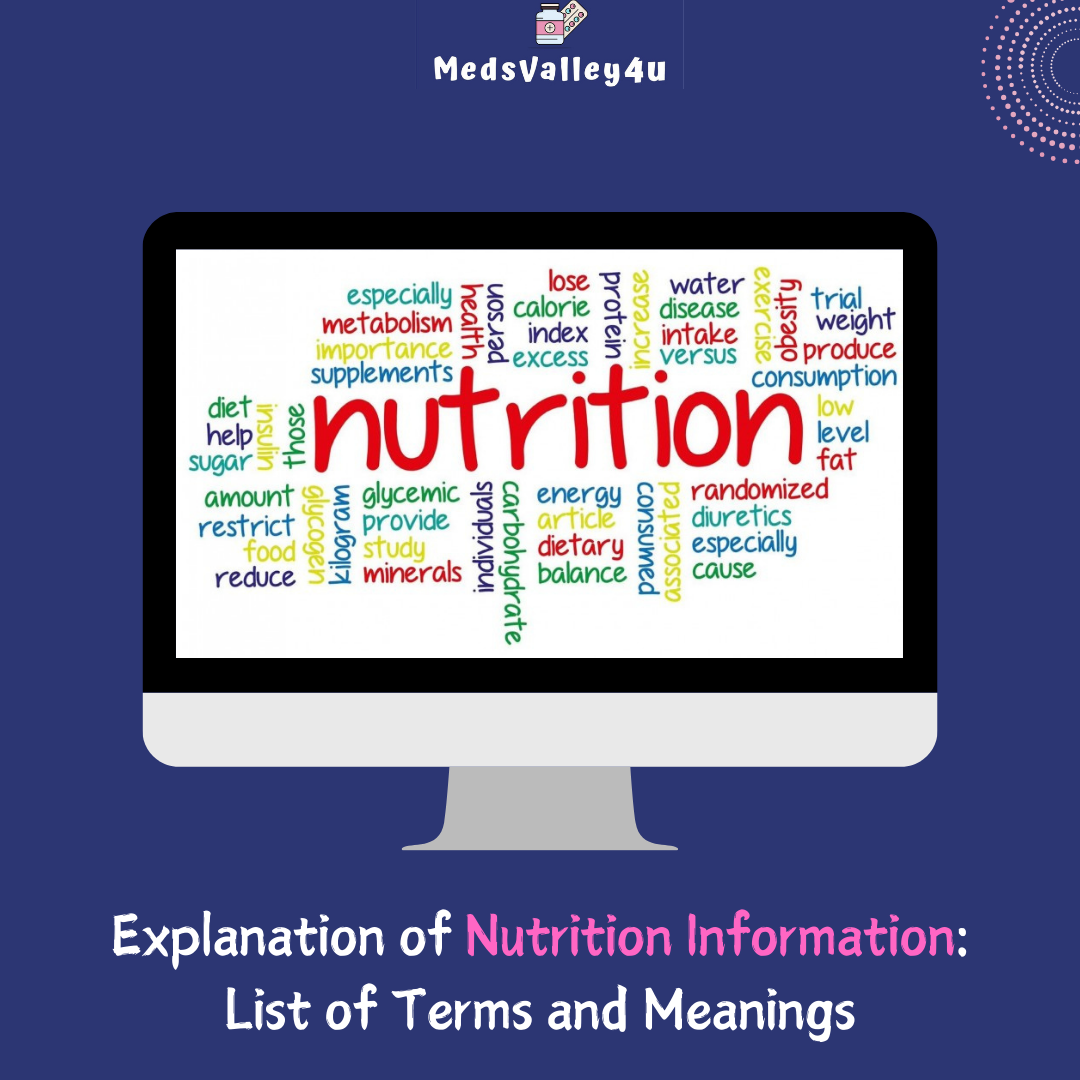Navigating the world of nutrition information can be overwhelming, especially with the vast array of terms and jargon used on food labels and in dietary guidelines. Understanding these terms is essential for making informed food choices that align with your health goals. This article will provide a comprehensive explanation of common nutrition information terms, helping you decode food labels and better understand nutritional content.
1. Calories
Calories are a unit of measurement used to quantify the amount of energy provided by food. When you consume food, your body converts the calories into energy to perform daily activities. Understanding calorie content is crucial for managing weight; consuming more calories than you burn can lead to weight gain while consuming fewer can result in weight loss.
- Empty Calories: These are calories from foods that provide little to no nutritional value, often found in sugary snacks and beverages.
2. Macronutrients
Macronutrients are the primary components of food that provide energy and are required in larger amounts. There are three main types:
- Carbohydrates: The body’s primary energy source, carbohydrates can be simple (sugars) or complex (starches and fibers). Foods rich in carbohydrates include fruits, vegetables, grains, and legumes.
- Proteins: Essential for building and repairing tissues, proteins are made up of amino acids. Sources include meat, dairy, eggs, legumes, and nuts.
- Fats: Fats are essential for absorbing certain vitamins and providing long-term energy. They can be saturated (solid at room temperature, like butter) or unsaturated (liquid at room temperature, like olive oil).
Recommended Distribution
The acceptable macronutrient distribution ranges (AMDR) suggest that:
- Carbohydrates: 45-65% of total daily calories
- Proteins: 10-35% of total daily calories
- Fats: 20-35% of total daily calories
3. Micronutrients
Micronutrients include vitamins and minerals needed in smaller amounts to support various bodily functions. They play a crucial role in maintaining health and preventing diseases. Common micronutrients include:
- Vitamins: Organic compounds required for normal growth and development. Examples include Vitamin C (ascorbic acid), which supports the immune system, and Vitamin D, which is essential for bone health.
- Minerals: Inorganic substances that play roles in various physiological processes. Key minerals include calcium (for bone health), iron (for oxygen transport), and potassium (for fluid balance).
Importance
Micronutrients are vital for metabolic processes, and deficiencies can lead to various health issues. For instance, a lack of iron can lead to anemia, while insufficient vitamin D can result in bone problems.
4. Serving Size
The serving size is a standardized amount of food that is used to calculate nutritional information on food labels. It helps consumers understand how many calories and nutrients they are consuming based on a specific quantity. Serving sizes can be found in common measurements, such as cups, ounces, or pieces.
Context
It’s important to note that serving sizes can differ from portion sizes (the amount you actually eat). Being mindful of serving sizes can help with portion control and understanding caloric intake.
5. Percent Daily Value (%DV)
The %DV on food labels indicates how much a nutrient in a serving of food contributes to a daily diet based on a 2,000-calorie daily intake.
Understanding %DV
- 5% DV or less: Considered low; you may want to limit these nutrients.
- 20% DV or more: Considered high; aim to get enough of these nutrients.
The %DV helps consumers gauge whether a food is a good source of a nutrient, making it easier to make healthier choices.
6. Dietary Fiber
Dietary fiber is a type of carbohydrate that the body cannot digest. It is essential for digestive health and helps regulate blood sugar levels. Fiber is classified into two types:
- Soluble Fiber: Dissolves in water and can help lower cholesterol levels. It’s found in oats, beans, and fruits.
- Insoluble Fiber: Does not dissolve in water and aids in digestion by promoting regular bowel movements. It’s found in whole grains, nuts, and vegetables.
Recommended Intake
The recommended daily intake for fiber is about 25 grams for women and 38 grams for men. Most people fall short of this recommendation, making fiber-rich foods essential for a healthy diet.
7. Added Sugars
Added sugars are sugars and syrups added to foods during processing or preparation. They provide calories but little to no nutritional value, leading to what are often called “empty calories.”
Common Sources
Common sources of added sugars include sodas, candies, baked goods, and some sauces. The American Heart Association recommends limiting added sugars to no more than 6 teaspoons (25 grams) for women and 9 teaspoons (38 grams) for men per day to reduce the risk of chronic diseases.
8. Trans Fats
Trans fats are a type of unhealthy fat created during hydrogenation, a process that turns liquid oils into solid fats to improve shelf life. Trans fats are linked to an increased risk of heart disease and should be avoided as much as possible.
Regulation
Many countries have introduced regulations to limit or ban the use of trans fats in food products. Checking labels for “partially hydrogenated oils” is essential, as this indicates the presence of trans fats.
9. Sodium
Sodium, primarily found in salt, is an essential mineral that helps maintain fluid balance and supports nerve and muscle function. However, excessive sodium intake can lead to high blood pressure and other cardiovascular issues.
Recommended Intake
The American Heart Association recommends limiting sodium intake to no more than 2,300 milligrams per day, ideally aiming for 1,500 milligrams for most adults, particularly those with high blood pressure or cardiovascular risk factors.
10. Probiotics and Prebiotics
Probiotics are live bacteria that provide health benefits when consumed in adequate amounts. They are often referred to as “good” bacteria and can help maintain a healthy gut microbiome.
Prebiotics
Prebiotics, on the other hand, are non-digestible food components that promote the growth of beneficial bacteria in the gut. They are typically found in fiber-rich foods, such as onions, garlic, and bananas.
Importance of Gut Health
Maintaining a healthy gut microbiome is essential for overall health, as it can impact digestion, immunity, and even mental health.
11. Organic and Non-GMO
- Organic: Foods labeled as organic are produced without synthetic pesticides, herbicides, or fertilizers. They are also free from genetically modified organisms (GMOs). Organic farming practices emphasize sustainability and environmental health.
- Non-GMO: Non-GMO foods are not made with genetically modified organisms. While not all non-GMO foods are organic, this label can appeal to consumers who want to avoid GMOs in their diets.
12. Gluten-Free
Gluten-free foods are those that do not contain gluten, a protein found in wheat, barley, and rye. For individuals with celiac disease or gluten sensitivity, consuming gluten can lead to serious health issues. However, for those without these conditions, there is no health benefit to avoiding gluten.
Conclusion of this Article:-
Understanding nutrition information is crucial for making informed dietary choices. Familiarity with terms such as calories, macronutrients, micronutrients, and food labels can empower consumers to choose healthier options that align with their dietary needs and goals. By recognizing the meanings behind these terms, you can navigate the complexities of nutrition with confidence, leading to better overall health and well-being. Taking control of your diet and understanding what you eat can significantly impact your quality of life and longevity.







Write a comment
Your email address will not be published. All fields are required